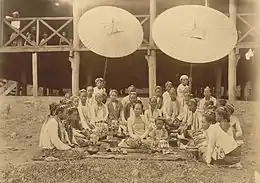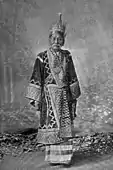| Chaopha | |
|---|---|
 | |
| First holder | Various |
| Last holder | Chao Pha Purandar Singha |
| Status | Defunct |
| Extinction date | 20th century |
| A nobility title used by Tai rulers | |
Chaopha (lit. 'lord of the sky') was a royal title used by the hereditary Tai rulers in mainland Southeast Asia, including the Mong Dun, Mong Shan, Mong Mao, and Khamti fiefdoms.
Names and etymology
The title literally means "lord of the heavens" in Tai languages, including chaopha (𑜋𑜧𑜨 𑜇𑜡) in Ahom, saopha (Shan: ၸဝ်ႈၽႃႉ, romanized: tsaw3 pʰaa5) in Shan, chau-fa (Tai Nuea: ᥓᥝᥲ ᥜᥣᥳ) in Tai Nuea, and chao fa (Thai: เจ้าฟ้า) in Thai.[1] The title was rendered into Burmese as sawbwa (Burmese: စော်ဘွား).[1]
Usage
Myanmar (Burma)
In the pre-colonial era, the term 'sawbwa' was utilised by the Burmese monarchy in reference to the hereditary rulers of Shan-speaking polities called mong (Shan: မိူင်း, pronounced [mə́ŋ]), in the region.[1] In order of precedence, the sawbwas outranked local rulers of lower ranks, namely the myoza and ngwegunhmu.[1]
During British colonial rule, colonial authorities adopted the Burmese system, recognising between 14 to 16 sawbwas who enjoyed a degree of autonomy in their fiefdoms.[1] In 1922, the establishment of the Federated Shan States greatly reduced the sawbwas' autonomy.[1] In April 1959, the sawbwas relinquished their feudal authority to the Burmese government.[1]
China
The term was also used for the rulers of some Tai polities in what is now China's Yunnan Province.[2]
Gallery
See also
References
- 1 2 3 4 5 6 7 Seekins, Donald M. (2017). Historical dictionary of Burma (Myanmar). Historical dictionaries of Asia, Oceania, and the Middle East (2nd ed.). Lanham: Rowman & Littlefield. ISBN 978-1-5381-0183-4.
- ↑ Donald M. Seekins (2006). Historical Dictionary of Burma (Myanmar). Scarecrow Press. entry Sawbwa, p. 391.
External links
 Media related to Saopha at Wikimedia Commons
Media related to Saopha at Wikimedia Commons
_at_the_Durbar%252C_Delhi%252C_India.jpg.webp)

